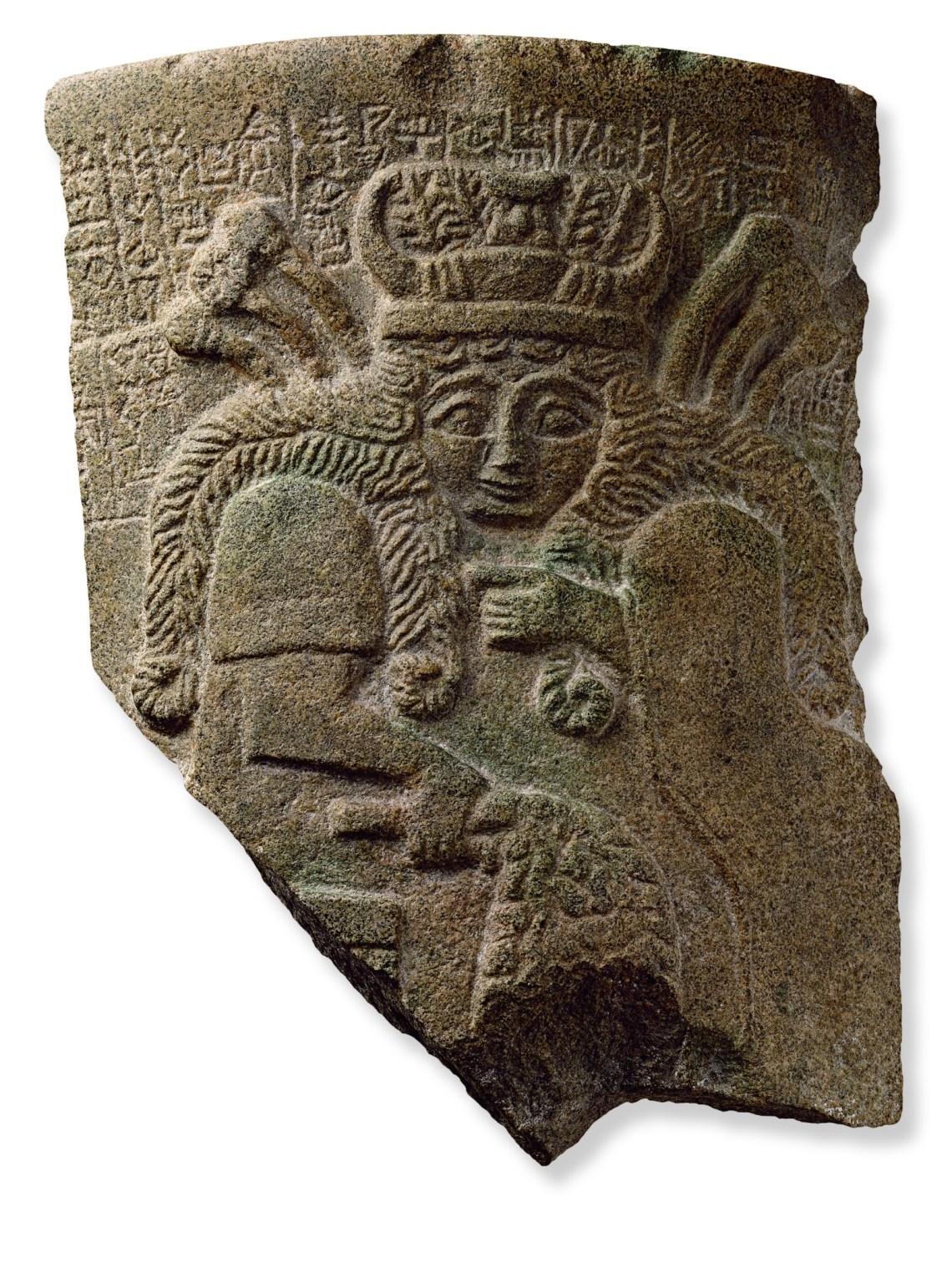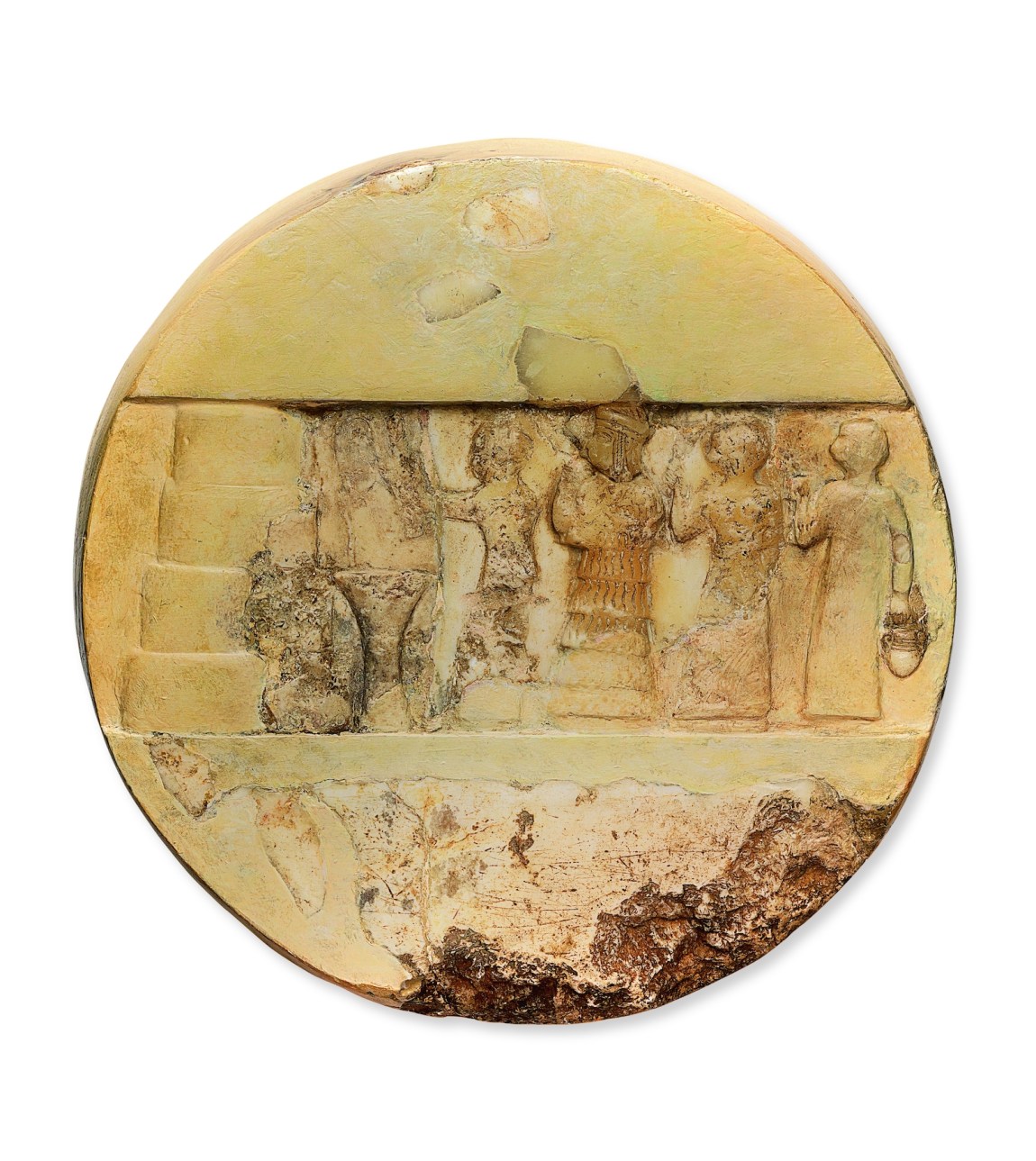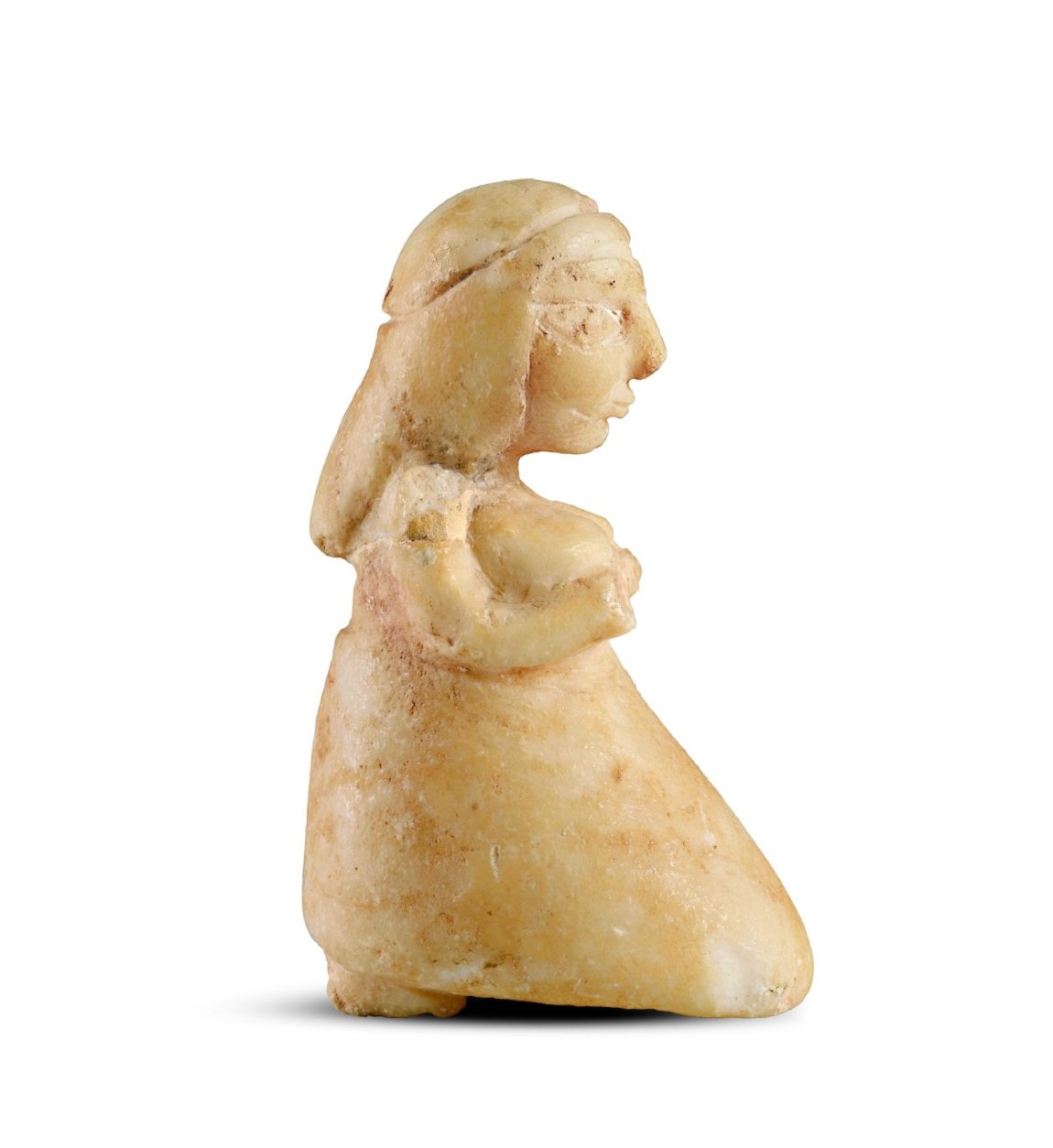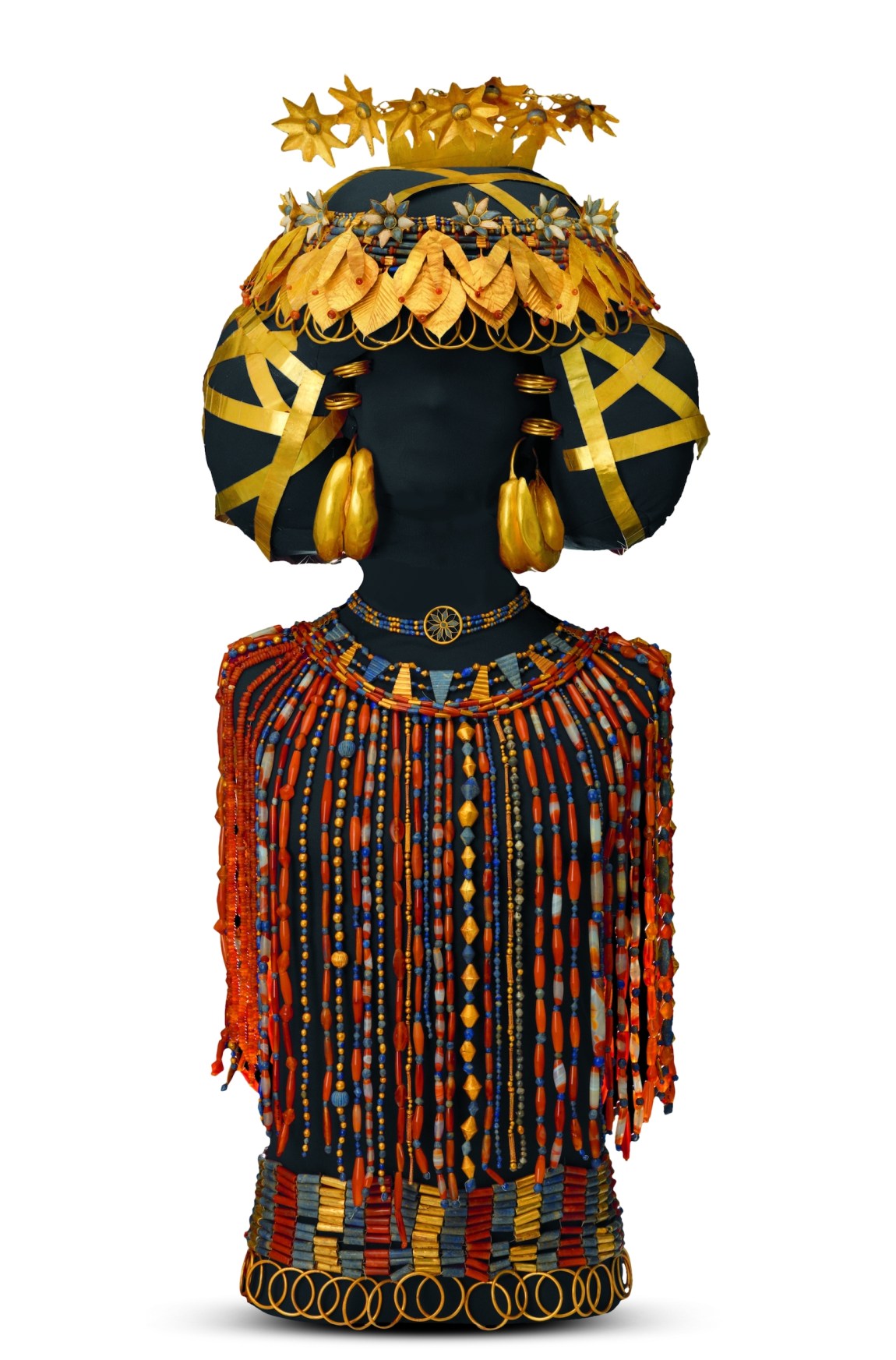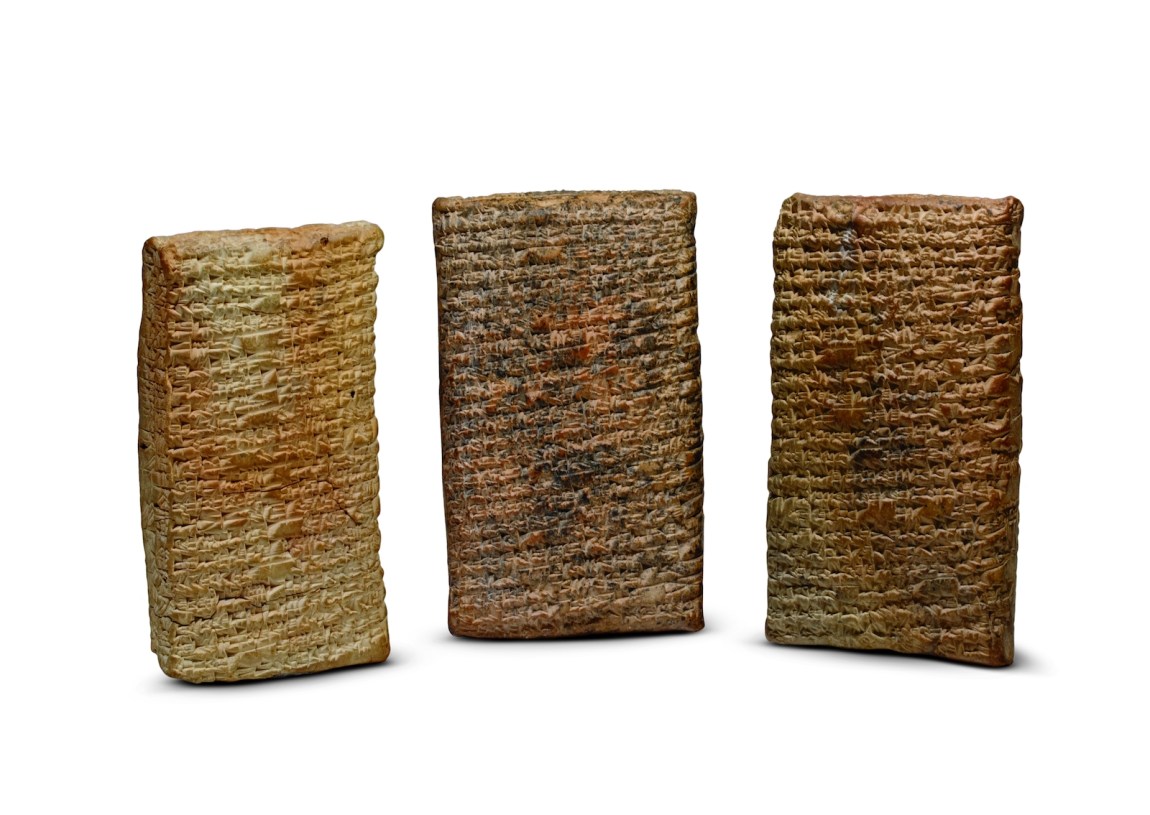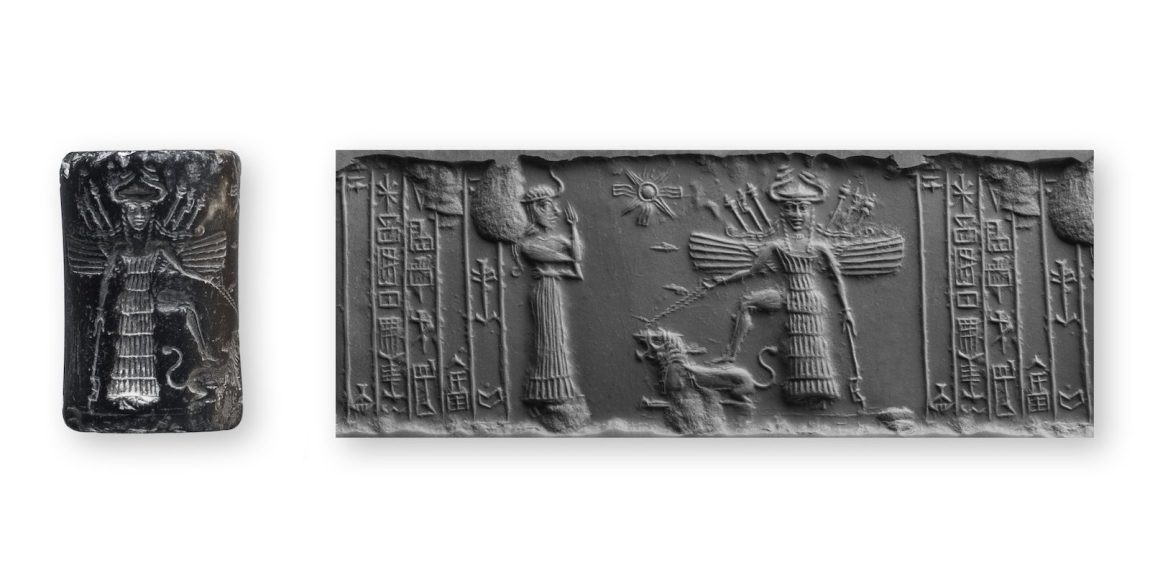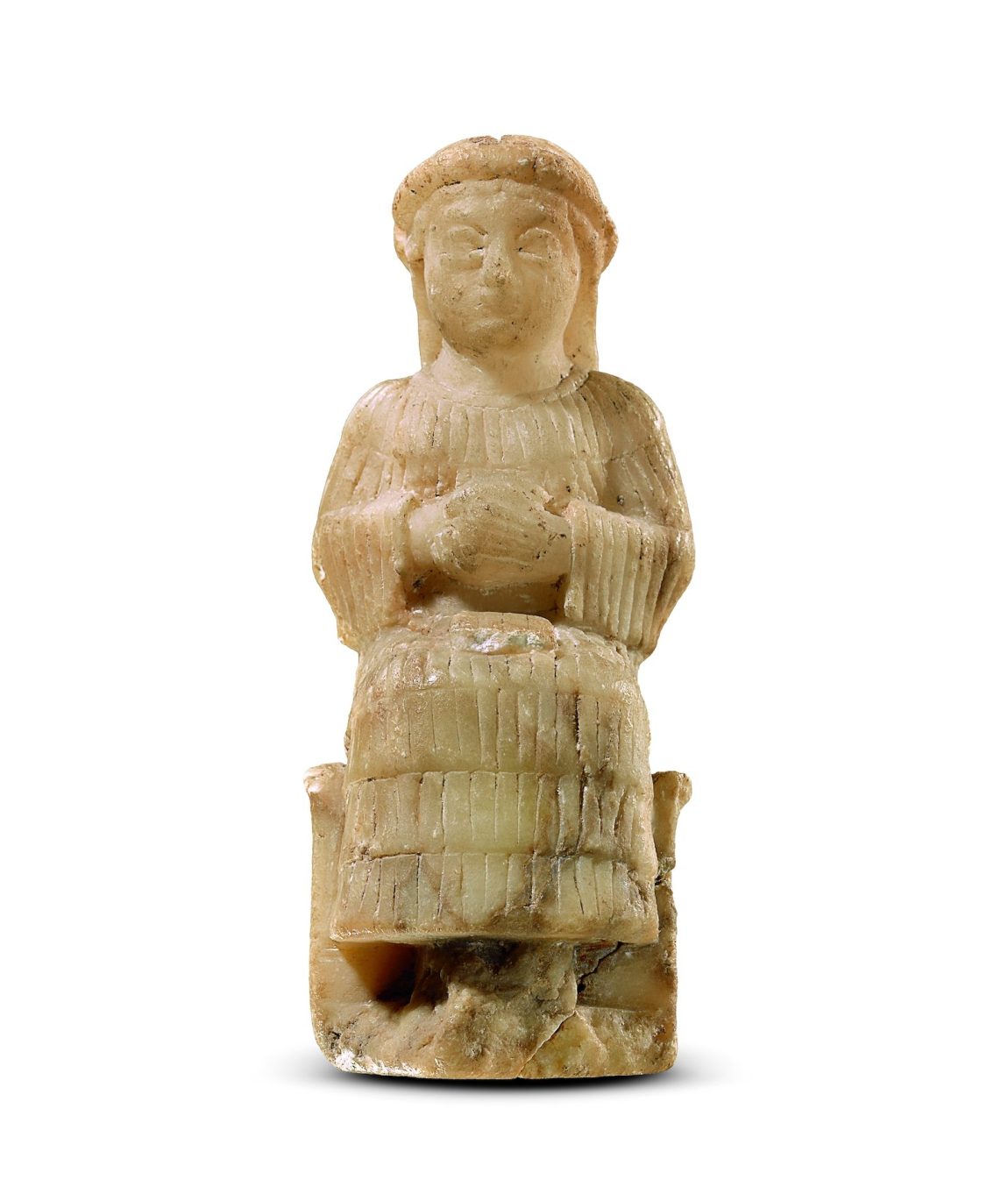In 1927 the English archaeologist Leonard Woolley wrenched the shattered pieces of a woman’s portrait from the ruins of an ancient temple in southern Iraq. To Woolley, it seemed to be just a “sadly-battered alabaster disk,” valuable only for its connection to the Akkadian king Sargon the Great, who conquered the Sumerians around 2334 BC and established the first empire in recorded history. The portrait was of his daughter, Enheduanna, and appeared to have been deliberately defaced. Depicted in the center of the disk, she presides over a nude male priest performing a ritual. Damage obscures the lower portion of her body, and her feet are missing, but her profile survives with startling precision, as does her rolled-brim crown and braided hair. A tiered temple, cartoonish in the distance, echoes the flounces of her cultic attire.
A few decades later this fragmented woman was revealed to be the writer of some of Mesopotamia’s oldest and most celebrated poems, the world’s earliest known author, who lived some fifteen centuries before Homer. Enheduanna composed hymns that synchronized local religious traditions across the Akkadian Empire, and singled out the goddess Inanna, a feathery-winged deity of paradox and transformation later known as Ishtar, as the most powerful figure in the divine pantheon. For many twentieth-century historians, this legacy was too extraordinary to have been true, her poetry too important to have been authored by a woman.
The Morgan Library & Museum’s exhibition She Who Wrote: Enheduanna and Women of Mesopotamia, ca. 3400–2000 BC casts the poet in a valuable new light. Bringing together over ninety artifacts from collections around the world, the curators Sidney Babcock and Erhan Tamur situate Enheduanna at the center of a sweeping narrative that traces representations of women and goddesses from the beginning of civilization to the centuries following her life, when she was revered as a canonical poet. Many claims can be made about her literary influence, on texts ranging from the Old Testament to the Homeric Hymns, but the exhibit grounds Enheduanna in her civilization, giving her what Saidiya Hartman has called “the gravity and authority of [a] historical actor” in a world where there was nothing particularly radical about women in positions of power.
The few fragments that survive from Enheduanna’s life—such as her portrait, her poems, and objects that belonged to her servants—suggest the many parts she played. As high priestess of the moon god in the humid port city of Ur, Enheduanna inhabited an already ancient Sumerian position vested with the highest religious authority, likely held by generations of royal daughters in a society where some women could inherit property and become professional scribes, musicians, and dream interpreters, among other occupations. Yet she was also an Akkadian princess, the daughter of the conqueror who razed Ur’s staggering walls, which made her position in the city fraught. Over the course of her long life—some historians estimate she lived over seven decades—she survived countless Sumerian rebellions and royal assassinations, while composing some of the most sophisticated and complex poems of ancient Mesopotamia.
*
At the Morgan, limestone figurines greet visitors with gaping eyes, their sockets gouged of the gems that once filled them, an intimidating threshold to a room full of women chiseled out of soft white stone. These objects, according to Mesopotamian tradition, were portraits commissioned as divine offerings, placed before altars to immortalize their subjects in gestures of worship. The women look rapt, humbled in the face of the unknown, and clasp their hands reverently in front of their chests.
The first half of the exhibit traces the lineage of Sumerian-speaking women who lived in the millennium before Enheduanna. An unassuming alabaster figurine just over two inches high dates from around 3300 BC, when the first cities were built in marshlands and writing was invented by pressing dried reeds into clay. She gazes across the room toward a figure from around 1800 BC. The intervening centuries were ones of great cultural and political innovation: writing evolved from an accounting system into a full-blown script; localized rule of Sumerian city-states gave way to an empire; deities were represented anthropomorphically for the first time. Given these changes, the portraits’ continuity is striking. Halolike headbands ornament their coiffed hair, simple robes cling to their bodies, and their lips are pursed in contemplation. But the later figurine stands tall and retains her original eyes, made of shell and bitumen. Both women’s pious stances bring to mind the central place of devotion in Enheduanna’s poetry. In her masterpiece The Exaltation to Inanna, she addresses the goddess: “Let me speak to you my prayer/my tears flowing like some sweet intoxicant.”
Advertisement
As can be seen in a plaster cast of the famous Uruk Vase (ca. 3300–2900 BC), which depicts Inanna’s reed-flanked temple as the life-source of Sumerian civilization, religious devotion was not just a personal affair. Temples were the economic and political centers of cities, responsible for countless administrative duties, including managing vast agricultural estates, food rations, trade, and even taxation. Cylinder seals, which performed similar functions to modern-day IDs, are engraved with women preparing divine offerings, sitting on thrones, drinking beer from giant straws, performing in all-female bands with a bull-headed lyre raised in celebration, and working in the region’s most important industries: milking cows, molding vases, and weaving textiles. One seal made of serpentine depicts a group of women operating a loom, their bodies caught in a great rush of movement.
In a new translation of her poems, by Sophus Helle, Enheduanna describes herself as “the weaver of the tablet.”1 Helle argues that Enheduanna compares her writing practice to pulling threads from a larger textile and rearranging them into a new pattern. Little is known about the function of poetry in Enheduanna’s lifetime, but later poems suggest that the Sumerian hymn was a religious genre, performed by cultic singers to communicate with the divine and prevent impending catastrophes, including foreign invasions and flash floods that leveled cities. As the historian Marc Van de Mieroop writes, authorship in ancient Mesopotamia “was more complex than a single person who stood at the point of origin” and involved a large network of people who performed, preserved, and modified a given text.2 The exhibit’s communal choreography—dozens of figurines form diagonals across the room—honors this image of Enheduanna as a figure whose role extended far beyond her specific life. By around 1800 BC she had become a literary celebrity: her poems are included in the most popular scribal curriculums from the Old Babylonian period and were studied alongside early versions of Gilgamesh. Her own heavily restored portrait is positioned off to the side, as if intentionally out of the spotlight.
The exhibition primes us to interpret Enheduanna’s image as a Mesopotamian might have: a prominent woman foreshadowed by those who came before. The bejeweled funerary attire of Puabi, a queen who ruled Ur in the twenty-sixth century BC, is displayed in the center of the room. Her elaborate garb is a harmonious assemblage of the most valuable materials of the time: strings of lapis lazuli hauled from the mountain passes of Afghanistan, clusters of carnelian from the Indus Valley, and ribbons of gold envelop her reconstructed hair. We can imagine that Enheduanna was adorned no less abundantly. The exhibit also includes portraits of high priestesses who lived after Enheduanna, some of whom appear to have been styled in her honor, such as an alabaster woman from ca. 2112–2004 BC with a tablet on her lap, presenting her writing as a divine offering.
*
The curators’ emphasis on such artifacts can distract from Enheduanna’s poetry. The surviving tablets, inscribed centuries after her death in esteemed scribal schools across the region, were excavated around the same time that Woolley discovered her portrait. Six are displayed in a corner of the exhibition, but there are over a hundred extant copies of The Exaltation to Inanna alone. Clay is a uniquely durable writing material, and approximately 1100 verses of her poetry have survived, compared to Sappho’s 650, which were written on papyrus.
In a radical departure from an otherwise anonymous literary tradition, Enheduanna used poetry not just to extol a deity but also to tell her own story. It is Enheduanna’s subjectivity—her electrifying “I”—that distinguishes her from those who came before. “I am Enheduanna,” she announces in the middle of Exaltation. She describes being assaulted by a pretender to the throne, stripped of her priestly crown, and cast out of her temple into the wilderness. “A slobbered hand was laid/across my honeyed mouth,” she writes. “What was fairest in my nature/was turned to dirt.” She likens the creation of this poem to giving birth: “This filled me, this overflowed from me, Exalted Lady,/as I gave birth for you.” A seal depicting an intimate scene of childbirth is displayed at the Morgan. In its upper half it portrays a hero slaughtering a wild animal, suggesting an equivalence among the labors of childbirth, the labors of the hero, and the labors of the poet.
Inanna eventually answers Enheduanna’s prayers and restores her to her temple. The poems are cast as a kind of literary magic that enabled Enheduanna’s survival; their composition becomes a form of salvation. The Exaltation likely recounts a Sumerian rebellion that occurred under the reign of Naram-Sin, Enheduanna’s nephew, who crushed the revolt with such brutality that the Euphrates was said to run with blood. In royal inscriptions, Naram-Sin credits Inanna with his victory and becomes the first known ruler to proclaim himself a deity. Inanna is an instrument of power both in Naram-Sin’s propaganda and in Enheduanna’s poems, a divine figure who elevates the authority of priestess and king.
Advertisement
Enheduanna’s Inanna is a fearmongering goddess, a stark contrast to early representations of a smiling fertility deity. “Show that your stare is full of rage,” Enheduanna writes. “Show that you are unyielding, that you persevere.” Cylinder seals from the Akkadian period depict scenes from the poem Inanna and Ebih, in which the goddess crushes a disrespectful mountain. In one scene she grabs his giant head and prepares to press a dagger into his heart. Next she steps on his body, sending stones cascading. In the final image, his wiry leg sticks out from beneath a heap of rubble, eviscerated. The curators suggest that Enheduanna conflated the nurturing qualities of Sumerian Inanna with the warlike features of an Akkadian deity, which inspired a major shift in the goddess’s visual representation. These seals retain her characteristic, enviable mane of hair, but a muscular thigh sticks out of her dress, at once seductive and threatening. Majdolene Dajani writes in the catalog that her full-frontal position has the effect of “bridging or even breaking the boundaries between viewers and the scene,” forcing us to confront her power. In a similar way, Enheduanna’s insertion of her own name and story into her poems compels us to pay attention to what she has to say. Inanna becomes both violent and nurturing, evil and good.
Enheduanna’s most violent poem, Hymn to Inanna, which depicts Inanna soaring above every threshold, even the boundaries of gender, is not displayed in the show. “To turn man into woman, and woman into man,” Enheduanna writes, “are yours, Inanna.” If Hymn had been paired with royal inscriptions documenting her family’s imperial successes, like Naram-Sin’s, the exhibit might have revealed a less palatable dimension of Enheduanna’s legacy; one could argue that she was also a colonial figure whose literary vision supported her family’s expansionist ambitions. “Inanna, who holds her head high, taller than a mountain, who can oppose her?” she asks. “At her command, cities fall to ruins, houses lie desolate, sanctuaries become barren land.” In a colophon to her collection of temple hymns, she exudes a confidence typically shown by kings celebrating military triumphs, and even seems to be aware of her genre-breaking work: “My lord, that which has been created (here) no one has created (before).”
Perhaps the warmongering aspects of Enheduanna’s poems were a necessary political guise that helped her survive her chaotic times, but it is impossible to know whether, when she writes verses like “you devour corpses like a dog,” she is dramatizing the horrors of war to reveal its terror or reveling in Inanna’s prowess in battle. The lyrical ambiguity of her work, and the many mysteries about her life, leave her open to projection. The fact that she wrote most of her poems to Inanna despite being the moon god’s priestess suggests an intense spiritual devotion to this deity, her muse. Inanna was conceived as the moon god’s daughter, and Enheduanna was the daughter of the king. “She was beautiful beyond compare,” she writes in Exaltation. “She was as lovely as a moonbeam streaming down.”


